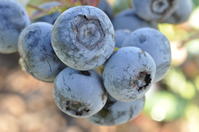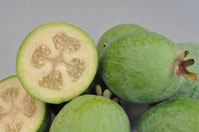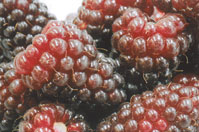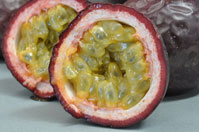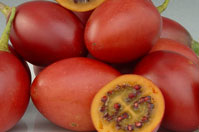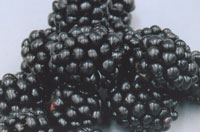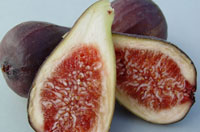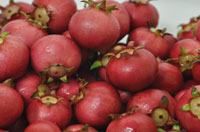
Tamarillo |
Cyphomandra betacea |

|
Key Points
- A quick return crop with the first harvest approximately 18-20 months from planting.
- Requires a warm, frost-free situation.
- Relatively low orchard establishment costs.
- Long picking season with the main flush in mid-winter.
- Needs careful management to produce high quality fruit.
Climate
Temperature
Tamarillos love the heat so long as they are also provided with sufficient moisture for healthy growth. The ideal would be, minimum temperatures of around 10°C year-round with minimum daytime temperatures of 15°C through the main growth period from November to May.
Frost Tolerance
Very sensitive to frost. Even one or two degrees of frost can cause tissue damage and reduce the potential cropping of mature trees and may fatally damage recently planted seedlings. Persistant heavy frosts can kill even well-established trees.
Chill Hours
N/A
NZ climate charts
You can read more about NZ's Cold Hardiness and Climate Zone here
Wind/Shelter
Good shelter is vital as quick-growing tamarillos are very brittle, have large soft leaves and tend to be shallow-rooted so exposure to strong winds can cause serious damage. If the chosen site isn't already sheltered, estabishing live shelter belts before planting is a must to help to filter the wind and keep the site warm as well as providing the added bonus of reduced soil moisture loss during dry spells. Planting in relatively small, sheltered blocks of around .25 of a hectare, helps to provide effective protection.
Sunshine Hours
Tamarillos love long hours of sunshine so long as they are not exposed to hot, drying winds.
Rainfall
The best scenario for tamarillos throughout the growing season would be adequate moisture at the roots with warm, dry foliage, flowers and fruit. They require reasonably high soil-moisture levels throughout fruit development and ripening. Where natural rainfall is insufficient to satisfy this need, irrigation may be a wise investment.
Soil Requirements
Soil Type
Tamarillos do best in a well-drained, highly fertile sandy loam with good levels of organic matter to aid moisture retention through dry periods. Heavy, wet clays or very light, stony soils with poor moisture retention are generally unsuitable for commercial tamarillo production.
Drainage
Good drainage is essential for tamarillo production as they are extremely sensitive to poor soil aeration and consequently suffer badly during prolonged periods of water-logged soil conditions. Heavy, wet clays and low-lying sites that are prone to flooding are generally unsuitable as tamarillo roots are very susceptible to fungal attack and root rots.
pH & Soil Testing
An initial soil test should be taken to establish the base nutrient and pH levels and to establish if any corrective treatments are required. Tamarillos are fairly accomodating to pH readings anywhere between 5.8 - 6.5.
Spacing
A single or double row system can be used. Single rows 4m-4.5m apart with 1.5m-2m between the plants and with provision for a 4m access between each row requires approximately 1,200 to 1,500 plants per hectare. Double rows 1.5m-2m apart, with plants 1.5m-2m apart in the rows and with a 4m service way between each pair of rows, requires approximately 2,000-2,400 plants per hectare.
Crop Establishment
Selecting Varieties
Our tamarillos are grown using reliable seed sources from named varieties to ensure' true-to-type' healthy growth, and maximum yield.
Planting Time
The preferred planting time is mid-November when the soil is warming up and the danger of excessively cold temperatures should have passed.
Cultivation
Site preparation should commence up to 12 months prior to planting time to ensure that perennial weeds are eliminated and any drainage issues are resolved. Sub-soiling should be considered to further improve drainage and encourage deeper rooting. Planting strips should be worked to a fine tilth to provide ease of planting and to encourage rapid establishment of young plants.
Fertiliser
Any nutrient deficiencies or necessary pH adjustments indicated by the initial soil test should be corrected by incorporating suitable applications, ideally 6 months or so prior to planting. A few handsful of Blood and Bone may be incorporated into the planting hole to give the young plants a safe, slow-release feed as they become established.
Irrigation
Irrigation may not be necessary if planting in wet conditions but during dry spells sufficient water should be applied to thoroughly wet and settle the soil immediately after planting.
Tips
Take care that the roots are protected from the sun and are never allowed to dry out. Plant firmly and make sure that the roots are lightly covered with soil but avoid burying the plants too deeply. Staking is recommended in exposed situations to minimise potential root-wrenching as the young plants establish themselves.
Crop Maintenance
Fertiliser
Tamarillos are heavy feeders and, on most soils, nutrients will need to be topped up with suitable N.P.K fertiliser applications at critical times in the growth cycle. In general terms this involves dressings of approximately equal amounts applied just prior to pruning, another application one month later to boost spring growth and a final dressing in mid to late summer to help swell the developing fruit. Depending on orchard performance, plant appearance and the quantity of fruit harvested, regular soil and/or leaf testing can be useful to identify specific nutrient deficiencies.
Irrigation
Maintaining adequate soil moisture levels throughout the growing season will help to minimise plant stress and maximise possible yields. Where irrigation is used, good management skills are required to achieve the balance between too little and excessive irrigation as too much water can also create problems.
Where sprinklers are used, they need to be raised above the top of the foliage to allow even distribution. Drip irrigation is suited to tamarillo production because it delivers water directly to the roots whilst leaving foliage and fruit dry but, again, careful monitoring is required to ensure that system is working efficiently and that the trees are receiving the correct amount of water while, at the same time, minimising the chances of root-rots developing because of over-watering.Pest & Disease Control
A handful of insect pests can be troublesome to tamarillos. Whitefly can significantly reduce yields if they are present in large numbers and the honeydew they excrete can give rise to unsightly deposits of sooty mould on the fruit. Looper caterpillars can munch on the leaves of young plants but, generally, the damage caused by these pests has little effect on mature trees. Sap-sucking whitefly, green aphids and green vegetable bugs are of greater concern because , even if their sap sucking does not inflict serious damage, they can be the vectors for the several viruses to which tamarillos are susceptible.
Some of the fungal diseases that can affect tamarillos, such as phytophthora and other root-rots manifest themselves where the drainage is inefficent and/or at times of heavy rainfall and high humidity. Powdery mildew can severely damage both foliage and fruit resulting in dramatically reduced yields unless any outbreak is controlled quickly and efficiently. Careful observation and early intervention is critical to ensure effective control.Good orchard management and hygiene can do much to minimise the risks and the efficient control of pests and diseases is particularly crucial where markets demand completely blemish-free fruit. Most growers rely on a compehensive agri-chemical spray program for control. Whether or not to apply chemicals is a decision for the individual grower to make but here at Tharfield we use an I.P.M Services (2009) Ltd integrated pest management program that requires us to regularly monitor our crops, to maintain high standards of nursery hygiene and, where appropriate, to make efficient use of predator insects in order to minimise the need for chemical controls.Weed Control
Efficient weed control is important, not only because rampant weeds compete with the crop for precious nutrients, but they can also act as hosts for insects, fungal diseases and viruses to which tamarillos are susceptible. Persistant perennial weeds should be eradicated from the site prior to planting. Knock-down herbicides are usually used to control annual weeds around the plants but care must be taken to avoid contact with any part of the trees including the immature trunks. Things change constantly in the world of agri-chemicals so seek advice from your horticultural advisor before applying any herbicides around your crop. The shallow-rooting habit of tamarillos should be taken into consideration if manual or mechanical weeding methods are employed. Regular mowing of grass swards is usually used to control weeds in the service way between the rows.
Bird Control
Birds are not particularly attracted to tamarillos so no control measures are needed.
Pollination
Tamarillo pollen is spread mainly by bees and by the wind. Any shelter provided should allow some air movement around the trees by filtering and slowing, rather than completely blocking the wind. Healthy trees produce a succession of racemes of small flowers but it is usually for only a small percentage of them to develop into mature fruit. Fruit set to ripening takes around 5 to 6 months. As tamarillos are self-fertile good fruit set can be expected from a single cultivar planted in isolation.
Harvest & Handling
Picking
Because of the tamarillos habit of sequential flowering, harvesting a crop can extend over several months and will require a regular picking regime to ensure that the fruit is picked at the optimum level of maturity. Selection is based on skin colour and the fruit is plucked from the tree with the stalk attached.
Post Harvest
Despite having a fairly tough skin, tamarillos still need handling with reasonable care to minimise blemishes. They may require washing to remove dust and spray residue before being dried, graded and packed to suit market requirements. The fruit travels and stores well at cool temperatures and generally has a good shelf-life.
Expected Yield
Many factors can influence yields from commercial tamarillo production but a rough guide would be: 6 tonnes per hectare year 2 after planting, rising to an average 12-16 tonnes (20-25 tonnes are possible) per hectare for the following 4 or 5 seasons before starting to decline with the age of the block .
More Information
- Temperate and Subtropical Fruit Production, 2nd Edition - Edited by D.I.Jackson and N.E. Looney, CABI Publishing
- IPM Services (2009) Ltd
- The Tamarillo Growers Handbook' available from Tamarillo Growers Association (info@tamarillo.com)
Enquiry
Please email Andrew Boylan, andrew.boylan@edible.co.nz for quotes or for any other queries you may have regarding our products and services. Minimum orders of 50 units per variety.
So that Andrew can respond to your enquiery promptly, please tell us:
- Your address (so we have some idea of your climate)
- The variety you are interested in
- The approximate numbers required
- Whether you a new grower or an established producer?
Many thanks
